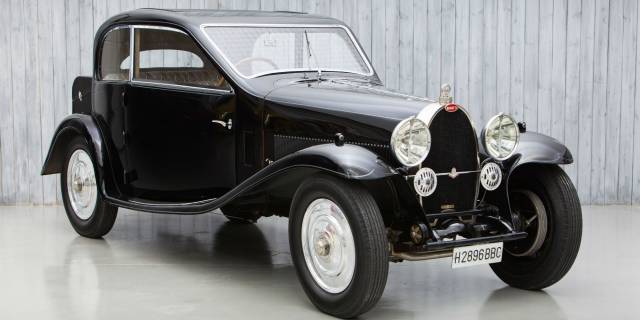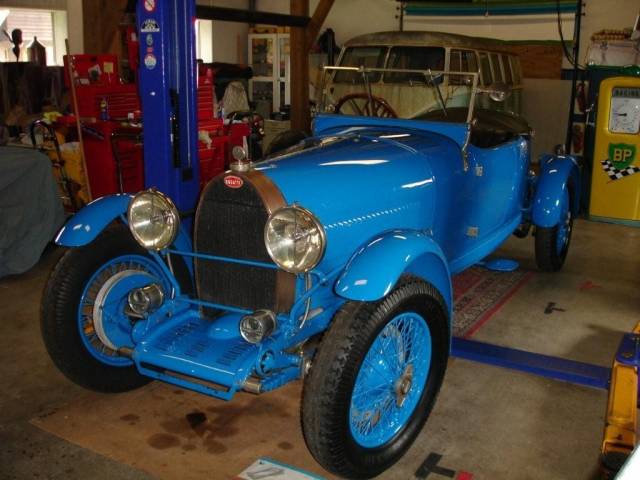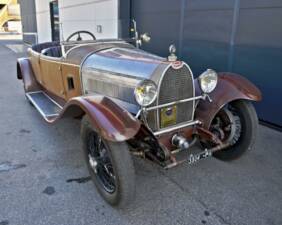- Automobile
- Bugatti
- Bugatti Type 44 (2 offerte)
Bugatti Type 44 classic car for sale
The Bugatti Type 44 stands out as the brand's refined answer to luxurious grand touring during the late 1920s. Powered by an advanced straight-eight engine and sharing its roots with other notable Bugatti models, the Type 44 marries technical precision with elegance and exclusivity. This model appeals to knowledgeable enthusiasts who appreciate authentic engineering, unmistakable period design, and the direct mechanical connection found only in vintage motoring.
Risultati della ricerca

1929 | Bugatti Type 44
3000cc 8 CILINDRI TORPEDO CARROZZATA GHIA TORINO – ASI NR. 1007 DEL 1982

Bugatti Type 44 listing references from Classic Trader
Below you will find listings related to your search that are no longer available on Classic Trader. Use this information to gain insight into availability, value trends, and current pricing for a "Bugatti Type 44" to make a more informed purchasing decision.

1928 | Bugatti Type 44
Coupé Fiacre, Coachwork by Gangloff.

1929 | Bugatti Type 44

1928 | Bugatti Type 44
By Gangloff

1929 | Bugatti Type 44
Grand Sport Body Style 43
History of the Bugatti Type 44
Launched in the mid-1920s, the Bugatti Type 44 was a direct evolution of the marque’s innovative 8-cylinder line, which began with the Type 30. Ettore Bugatti’s vision was to bring refined, high-performance automobiles to discerning clients seeking comfort and dynamic driving in one package. The Type 44 filled an important niche between the entry-level Type 40 and the more radical, sports-oriented Type 43. Its arrival marked a consolidation of Bugatti’s reputation for engineering sophistication, with the 3-litre straight-eight engine delivering notable smoothness and reliability for its era.
Model Series History: Bugatti's 8-Cylinder Lineage
The Bugatti Type 44 draws its technical DNA from predecessors such as the Type 30 and Type 38, all forming part of Bugatti’s 8-cylinder platform initiated in 1922. After the Type 44, Bugatti further developed this line with the larger and more powerful Type 49. The Type 44’s engineering choices—especially its chassis and drivetrain—reflect continuous refinement, resulting in a model that bridged the gap between comfort tourers and sports models in Bugatti’s range.
Special Features and Market Highlights
The Bugatti Type 44 features an advanced straight-eight engine for its time, with a three-litre displacement offering admirable flexibility and responsiveness. Buyers benefit from a finely-honed chassis, lightweight construction, and classical Bugatti aesthetics. The car’s interior and exterior were often extensively customised by master coachbuilders, resulting in highly individual examples.
Technical Data
Special Editions and Collectible Models
Official Bugatti factory did not designate specific 'special editions' of the Type 44, but period-correct custom coachwork from Carrosserie such as Gangloff, Million-Guiet, or Vanvooren elevated certain examples. Open tourers and elegant coupés built to client order are highly distinguishable from the chassis, increasing values and uniqueness.
Common Issues and Maintenance Considerations
No data currently available for specific weaknesses of the Type 44. However, like many Bugattis of this era, the complexity of the straight-eight engine and the precision of the chassis components mean that regular, specialist maintenance is essential. Parts availability can be constrained by the low production numbers and the bespoke nature of body and mechanical components. Potential buyers should seek examples with documented histories and, ideally, with recent mechanical restorations by marque experts.
Engine, Transmission and Driving Experience
The Type 44’s straight-eight, 3-litre engine delivers a blend of smooth torque and direct acceleration, especially when paired with the car’s relatively lightweight chassis. The manual gearbox and live axle offer an engaging, period-correct driving feel, requiring confident operation but rewarding with authentic feedback. Handling, while typical of the late 1920s, is enhanced by the chassis layout and careful weight distribution. Enthusiasts find the Type 44 well-suited to vintage driving events and rallies thanks to its robust engineering. Among the Type 44s, open tourers with four-seater coachwork and elegant coupé examples are the most highlighted by collectors due to their usability and style. Each car’s technical execution is largely influenced by the individual coachbuilder, underlining the importance of provenance when considering a purchase.
Interior, Comfort and Exterior Design
Coachbuilt exteriors by firms like Gangloff or Weymann give the Type 44 striking visual appeal—sweeping fenders, long hoods, and exquisitely detailed grilles are common. Interiors frequently feature polished wood dashboards, supple leather seating, and custom switchgear, all reflecting the high standards of luxury motoring of the era. Period accessories, including specialized luggage, bespoke hood ornaments, and unique colour specifications, are sometimes encountered in well-preserved examples. The individuality of each model is a direct result of the Bugatti customer’s ability to specify materials and details to their taste.
Other Noteworthy Facts
The Type 44 sits at an interesting historical juncture for Bugatti—between the world of Grand Prix racing and the rise of refined luxury motoring. Many chassis have complex ownership and competition histories, sometimes including participation in international concours events. Prospective owners often value these provenance aspects when evaluating examples for purchase.
Summary
The Bugatti Type 44 occupies a pivotal place in the marque’s 1920s legacy—merging technical ingenuity with elegant custom coachwork. Its 3-litre, straight-eight engine and bespoke body options make it a favourite for Bugatti specialists searching for authentic pre-war motoring. The model’s total dominance in current supply and demand for classic Bugattis underlines its unique status in today’s collector market.

